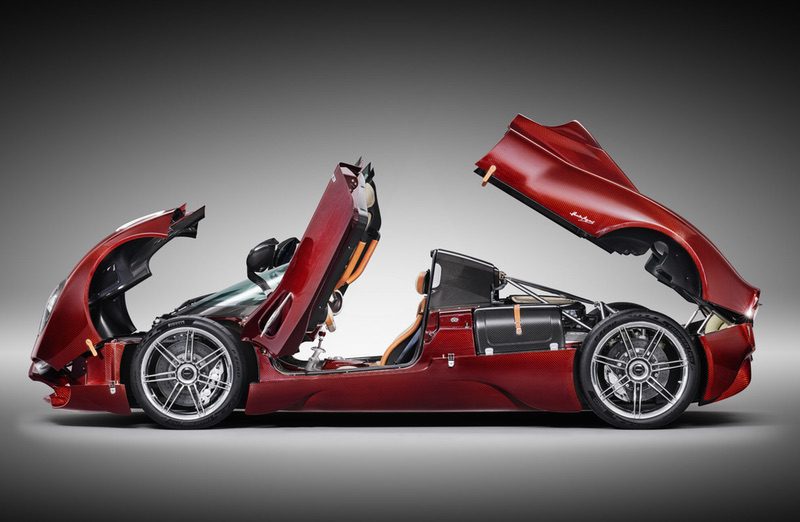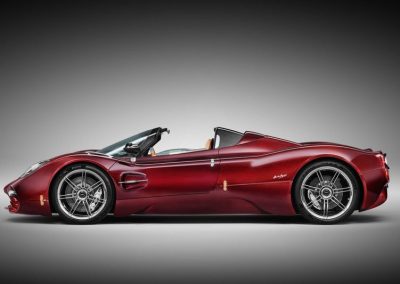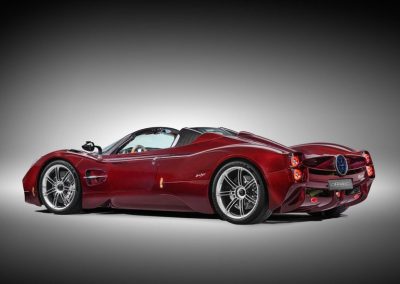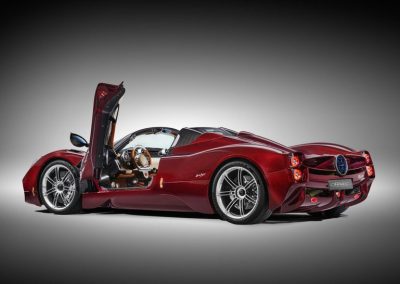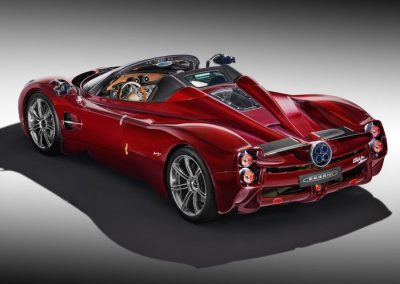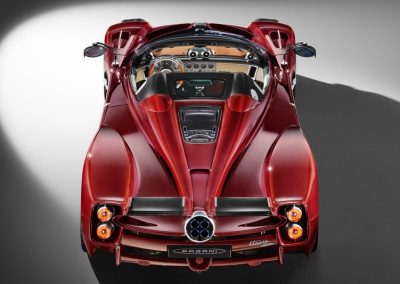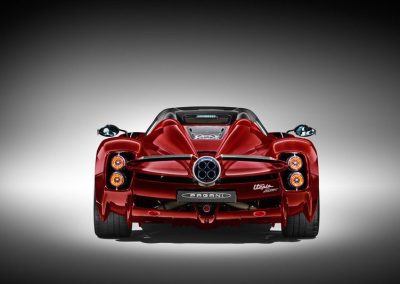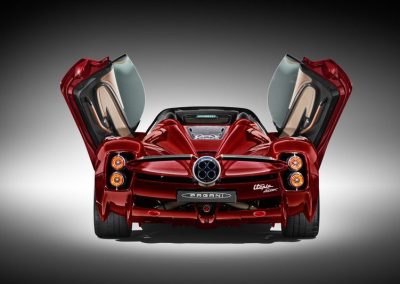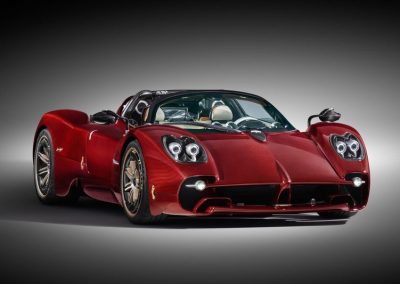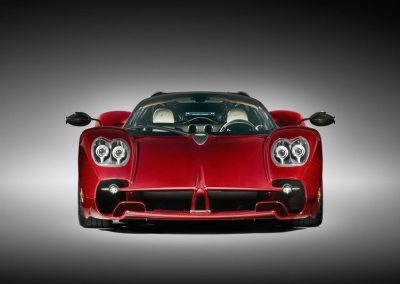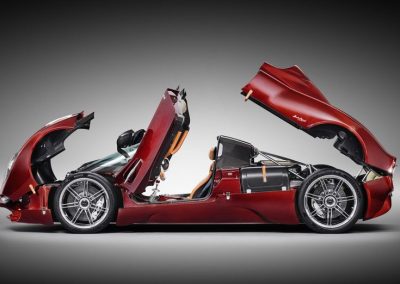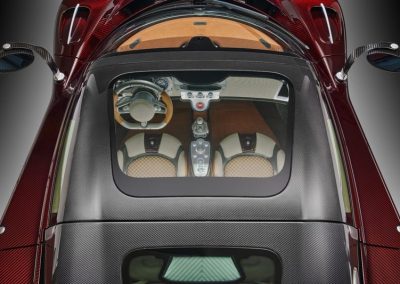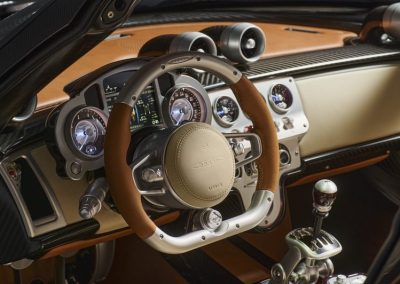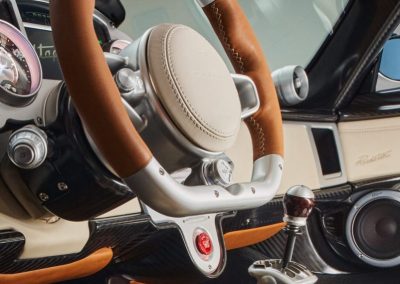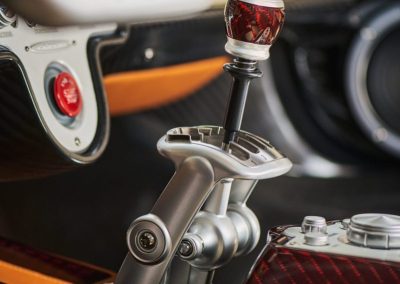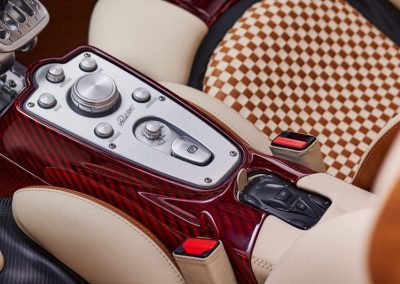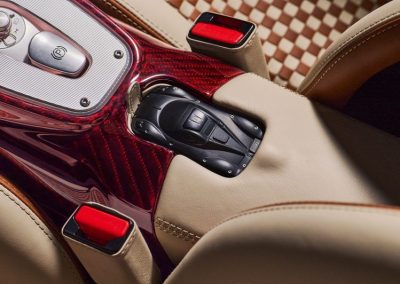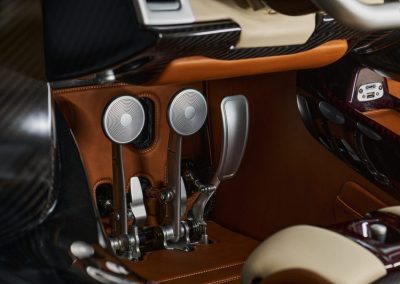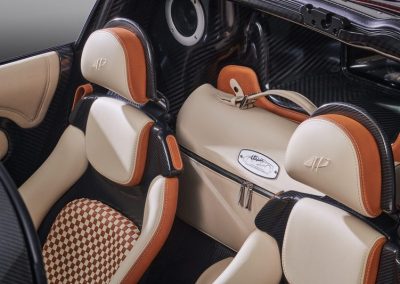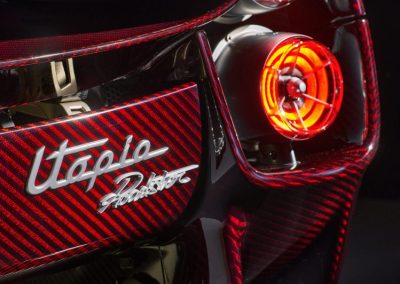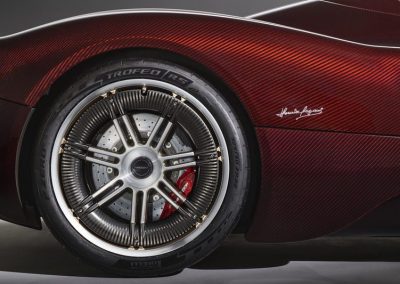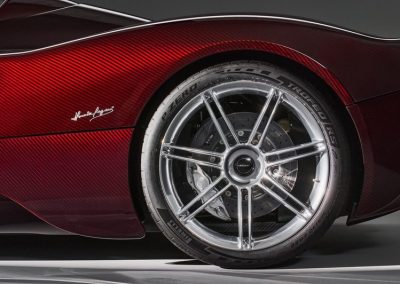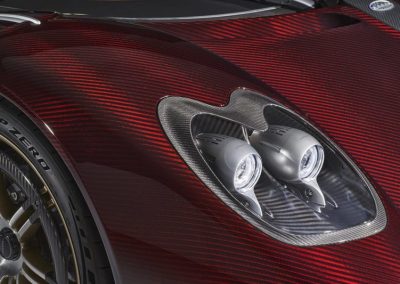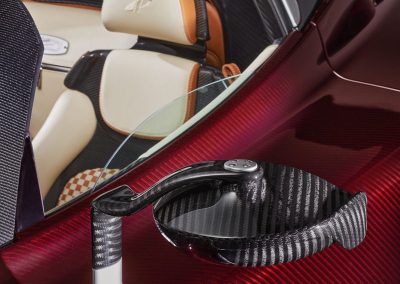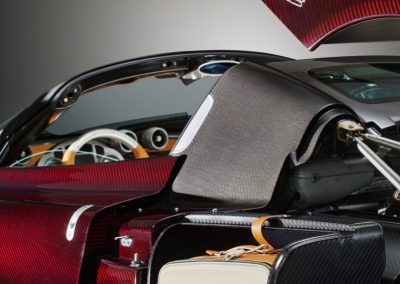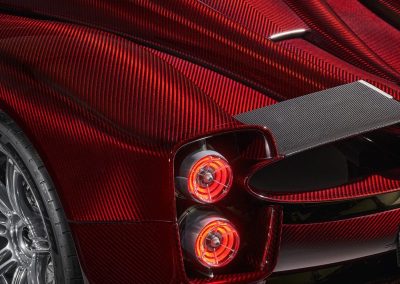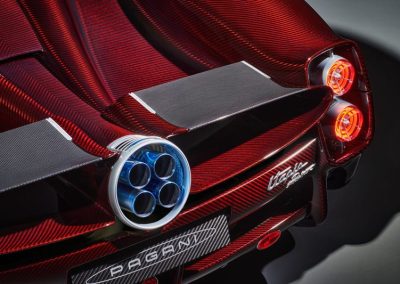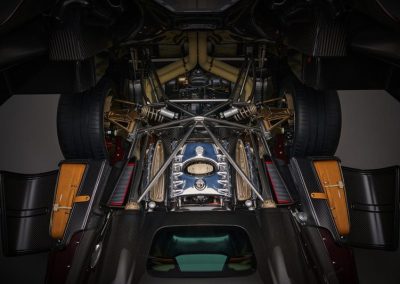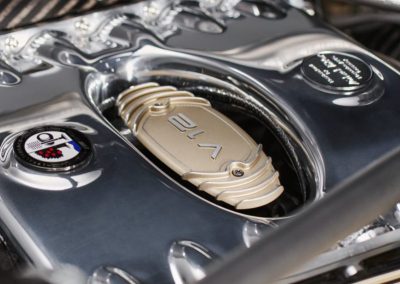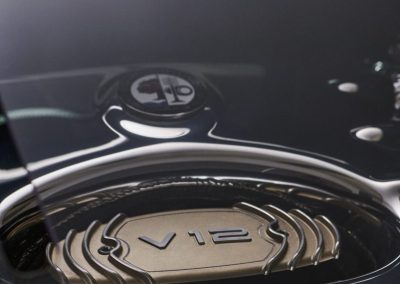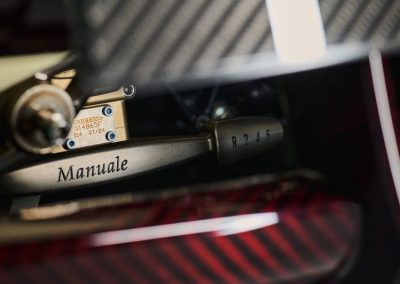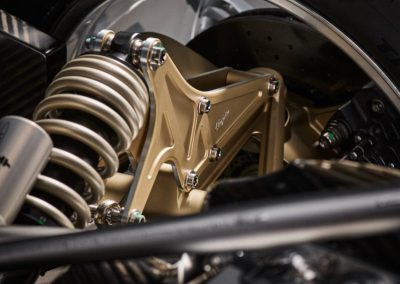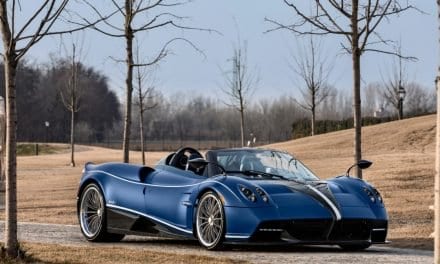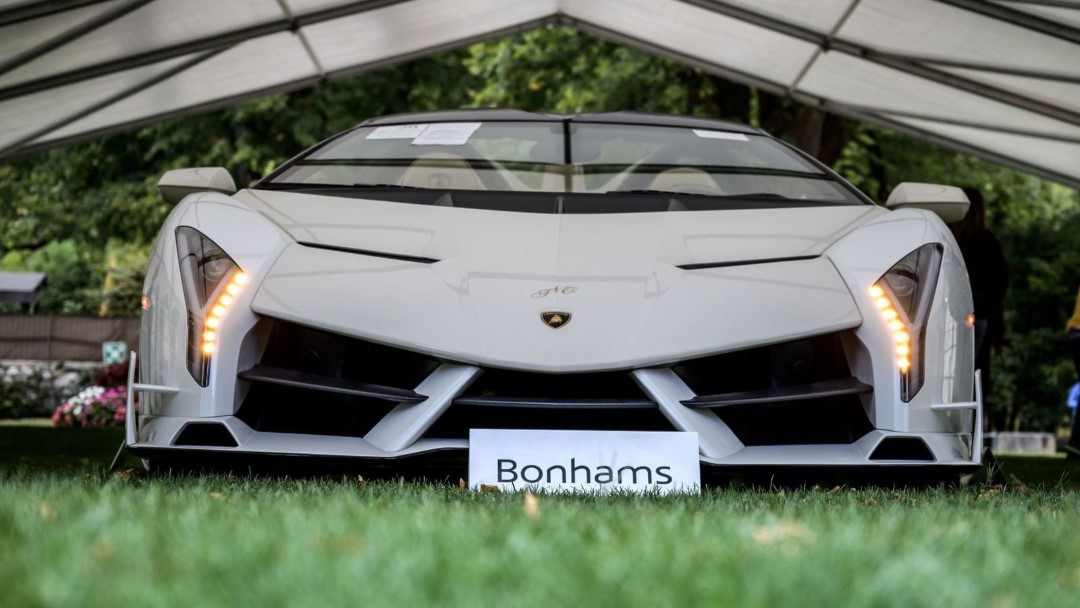1. Introduction
In the age of hybridisation and digital interfaces, the Pagani Utopia Roadster arrives as a soulful contradiction—an analog ode to craftsmanship, mechanical purity, and emotional driving pleasure. It is a car that asks a bold question in an era increasingly dominated by electric drivetrains and touchscreen everything: what if we didn’t compromise? What if we could still celebrate the art of driving?
Unveiled at the Monterey Car Week, the Pagani Utopia Roadster is more than just the open-top version of the Utopia Coupé. It is an entirely uncompromised hypercar that blends meticulous Italian artistry with state-of-the-art engineering. At its core lies a twin-turbo V12 engine—developed in collaboration with Mercedes-AMG—producing a thunderous 864 horsepower, and it comes paired with a seven-speed manual transmission. No hybrid. No touchscreen excess. Just raw, distilled performance and design.
This article explores every element of the Utopia Roadster, from its heritage and styling to its exquisite mechanical engineering, driving experience, and investment potential. Whether you’re a connoisseur, collector, or daydreamer, the Utopia Roadster represents a pinnacle moment in automotive artistry. Let us take you through the details that make it an icon in the making.
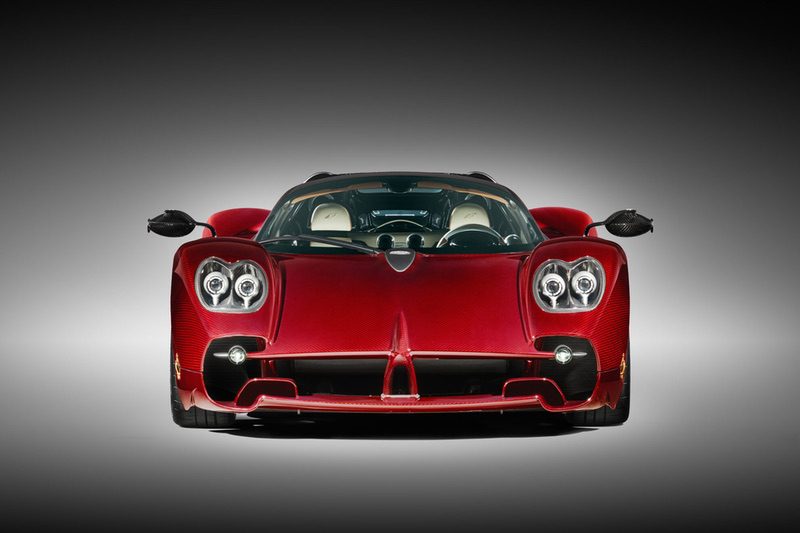
2. Heritage: From Zonda to Utopia Roadster
Pagani Automobili is not a car company; it is a design house, an atelier, and an artisanal laboratory of speed. Founded by Horacio Pagani in the 1990s, the marque made its debut with the Zonda, a V12-powered symphony of carbon and aggression that stunned the world. The Huayra followed, bringing active aerodynamics and a more refined aesthetic. Then came the Utopia Coupé in 2022, named after an elusive ideal, and designed to revive the pure joy of driving.
Unlike the Zonda and Huayra, whose Roadster versions were developed after their Coupé counterparts, the Utopia was conceived with dual identities from the outset. Project C10, as it was internally known, was envisioned as both Coupé and Roadster, developed in parallel by the same team of designers and engineers. This dual birth ensures that the Roadster is not a compromise but an equal.
In creating the Utopia Roadster, Pagani draws heavily on its heritage of combining uncompromising performance with timeless Italian design. It is a continuation of a lineage defined by carbon fiber monocoques, naturally aspirated aesthetics, and an unwavering dedication to the driver. And like its forebears, the Utopia Roadster aims to be not just a car, but a collector’s sculpture on wheels—a living legacy of form and function.
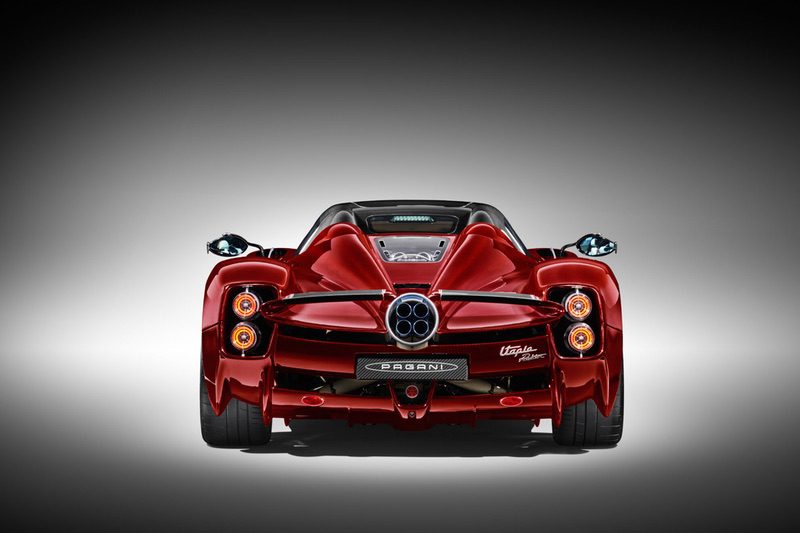
3. Exterior Styling: Sculpted by Air and Art
Viewed from any angle, the Pagani Utopia Roadster is a masterclass in fluid design and aerodynamic grace. The car is devoid of oversized aerodynamic appendages; instead, the airflow is subtly orchestrated through elegant lines, hidden flaps, and organic curves. The bodywork flows like liquid metal, shaped by both wind tunnel science and aesthetic philosophy.
The Utopia Roadster retains the distinctive butterfly doors from the Coupé, and its modular roof system allows for a hard-top, soft-top, or open-air experience. With the roof removed, the car transforms, not just visually but emotionally, allowing driver and passenger to be enveloped by the elements. Even with the hard-top in place, a panoramic roof window bathes the cabin in natural light.
Design references nod to timeless inspirations—the curves of 1950s Bianchi bicycles, the nautical lines of Riva speedboats, and the delicate intricacy of Vespa accessories. Pagani’s obsession with detail extends to the luggage compartments next to the engine, where leather-clad carbon suitcases reside, complete with exhaust-tip shaped feet.
The presentation model, unveiled in Habanero Red exposed carbon, shifts hues in changing light, capturing the dual nature of the Roadster: wild and elegant, brutal and refined. Every surface has purpose. Every line has poetry. This is automotive haute couture.

4. Interior Design: Haute Horlogerie in Motion
Step inside the Pagani Utopia Roadster and you enter a different world—one where every detail has been obsessively thought through and hand-finished. There are no digital gimmicks or oversized touchscreens here. Instead, what greets the driver is an homage to horology, engineering, and analog tactility.
The instrumentation is dominated by large mechanical dials that reveal their inner workings, framed in a layout that would look as at home in a Swiss timepiece boutique as in a hypercar. A central cluster of gauges provides critical information at a glance, allowing the driver to monitor oil pressure and temperatures with just a flick of the eye.
But the crown jewel of the cabin is undoubtedly the gear lever—a sculptural masterpiece with exposed titanium linkage, set in an open gate. It’s a monument to mechanical beauty, precision-milled from solid blocks of metal and finished with a gleaming polished knob. It doesn’t just look good; it transforms every gear shift into an event, reintroducing sensuality and engagement into the act of driving.
The steering wheel is another highlight, machined from a single block of aluminum over 28 hours, then hand-finished and wrapped in leather. It weighs just 1.6 kg yet exudes presence, purpose, and polish. Ergonomics throughout the cabin are human-centric: every button and lever falls exactly where you expect it, and each control is a satisfying blend of form and function.
Personalisation reigns supreme here. Clients can choose from nearly limitless combinations of leather, carbon, and anodised finishes. The interior, frequently exposed to admiring gazes when the roof is off, becomes a stage on which the owner’s personality is proudly displayed. Whether subtly monochrome or flamboyantly expressive, no two cabins are the same.
This is not just a place to sit and drive. It’s a sanctuary, a statement, and a studio of mechanical elegance. In the Utopia Roadster, art is not an afterthought—it’s the architecture.

5. Engine and Transmission: The Purist’s Powertrain
At the heart of the Pagani Utopia Roadster beats a powerplant that defies modern conventions: a 6.0-litre twin-turbocharged V12, developed exclusively for Pagani by Mercedes-AMG. This is no hybrid-assisted experiment or emissions-constrained compromise. This is a raw, unfiltered mechanical masterpiece that produces 864 horsepower and 1,100 Nm of torque. It is, in essence, a superlative expression of combustion—an ode to the dying art of the analogue hypercar.
What makes this V12 remarkable is not just the numbers, but the manner in which they are delivered. Unlike many modern turbocharged engines that rely on hybrid torque fill or digital trickery to mask lag, the Utopia’s V12 is startlingly responsive. Its throttle is crisp, and its voice is operatic—delivering a crescendo of sound and fury that stirs the soul. There’s no electric motor to cushion the sensation, no regenerative braking to dilute the experience. Just the pure, spine-tingling symphony of twelve cylinders firing in harmony.
This engine is paired with a choice of two transmissions, both developed in collaboration with British engineering firm Xtrac. The headline option—and the one true purists will be salivating over—is the seven-speed manual gearbox, operated through the iconic exposed linkage and gear gate. It’s as much an aesthetic centrepiece as it is a performance tool, offering tactile engagement that is nearly extinct in the hypercar world.
For those who prefer convenience without compromising engagement, Pagani also offers the AMT (Automated Manual Transmission) variant, controlled via steering-mounted paddle shifters. Though not as romantically mechanical as the gated manual, it is an engineering marvel in its own right—light, responsive, and capable of lightning-quick shifts without sacrificing mechanical feel.
The transmission is mounted transversely at the rear, contributing to the car’s compact packaging and optimal weight distribution. A triple-disc clutch helps manage the immense torque, providing progressive engagement whether you’re cruising in seventh or dropping gears under heavy braking.
In a world of seamless dual-clutches and EV propulsion, the Utopia Roadster chooses to celebrate effort, sensation, and feedback. It demands involvement. It rewards skill. And it transforms every shift, every downchange, and every redline pull into an unforgettable ritual.
This isn’t just a drivetrain. It’s the beating heart of Pagani’s philosophy—one where the soul of driving is preserved, one gear at a time.
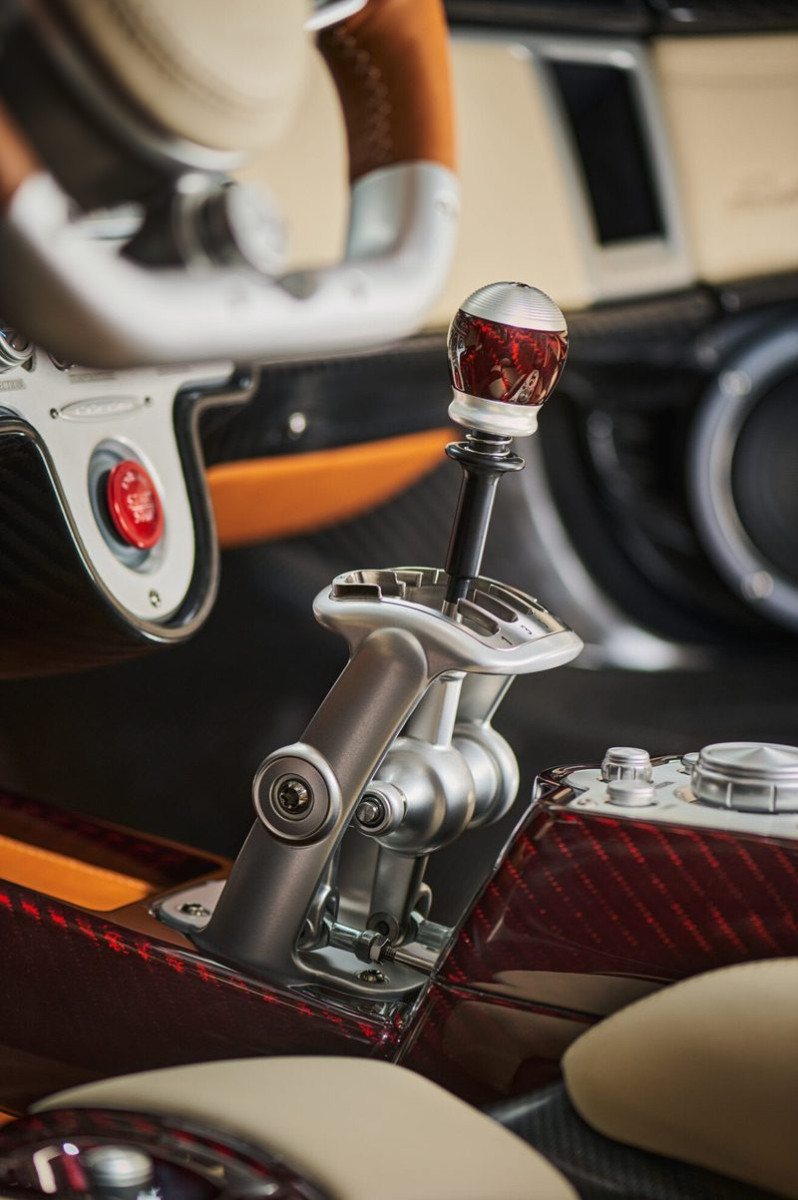
6. Performance and Handling: Lightweight Theatre on Four Wheels
The Utopia Roadster is not merely built for show—it’s engineered for sensation. At just 1,280 kilograms (dry weight), it matches the Coupé version gram for gram. This feat is made possible through the use of cutting-edge composite materials like Carbo-Titanium HP62-G2 and Carbo-Triax HP62, resulting in a monocoque chassis that is stiffer and lighter than most race cars.
Such minimal mass, when paired with 864 horsepower, translates into a power-to-weight ratio that launches the Utopia into hypercar legend. Acceleration is savage, yet controllable. The V12’s torque is instantly accessible, while the absence of hybrid weight means responses are immediate and unfiltered.
Aerodynamics play a silent but vital role in this ballet of physics. Instead of ostentatious wings, the Roadster employs harmoniously integrated movable flaps at the rear. These adjust dynamically based on speed and driving mode, balancing downforce and drag with surgical precision. The result? Stability at speed without sacrificing design purity.
Cornering is equally impressive. Double wishbone suspension crafted from aircraft-grade aluminum keeps the car composed and responsive. Active damping, electronic differential, and traction management work together to deliver confidence-inspiring grip and control. Yet Pagani ensures the driver is always at the helm, never overridden.
Then there’s the rubber. Pirelli P Zero™ Trofeo RS tyres, infused with Cyber™ Tyre sensors, provide constant feedback to the car’s electronic systems. This means optimal performance regardless of conditions—and crucially, safer, more precise handling.
Despite its extreme capabilities, the Utopia Roadster never feels twitchy or temperamental. It offers a sublime balance between rawness and refinement, aggression and civility. It doesn’t just perform—it performs with theatre, charisma, and grace.
This is not a track-day special pretending to be a road car. This is a hypercar that turns every road into a stage, every corner into choreography. The Utopia Roadster is a dynamic expression of Pagani’s belief: that performance must be thrilling, beautiful, and above all, human.
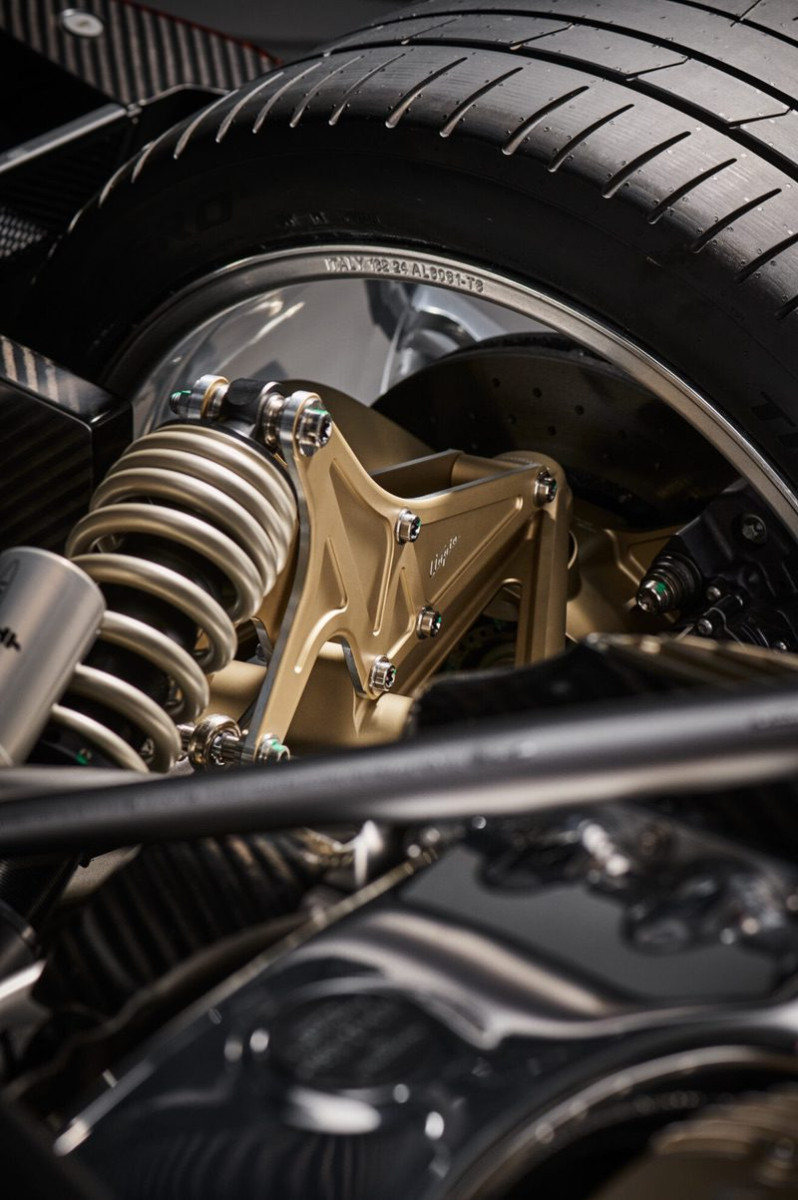
7. Driving Experience: Mechanical Romance, Redefined
Slip into the Utopia Roadster’s cockpit, and the world beyond the windshield seems to melt away. This is not a car you simply drive—it’s one you commune with. Every movement, every shift, every whisper of the engine is designed to elicit joy and connection.
From the moment you release the clutch and roll forward, it becomes clear: the Utopia Roadster isn’t intimidating, it’s inviting. The ride is supple yet communicative, allowing the car to flow over the road rather than conquer it. The steering is telepathic, delivering textures of tarmac and camber through your fingertips with a level of feedback that is becoming tragically rare.
As the revs climb and the V12 bellows its mechanical opera, each gear change becomes a ceremonial act. The open-gate shifter clicks home with satisfying precision, the clutch pedal gives just the right resistance, and the car responds like a dance partner who knows your every move. There’s no lag, no delay—just seamless dialogue between man and machine.
Driving the Utopia Roadster at pace isn’t just exhilarating—it’s enlightening. It doesn’t overwhelm you with electronic filters or digital interventions. It sharpens your senses, demands your focus, and rewards your mastery. Even in slow corners, the balance is impeccable, and at speed, the confidence it instills is addictive.
But it’s not all high-octane drama. There’s serenity in this machine too. Cruising in seventh gear with the roof off, the sun overhead, and the mechanical gauges glowing softly on the dash, you realise that this car is as much about the journey as it is about the thrill. It makes the mundane magical, the ordinary extraordinary.
Pagani hasn’t just built a Roadster. They’ve built an experience—one that rekindles the forgotten romance of driving. It’s a sensory affair, a mechanical symphony, and a philosophical statement all rolled into one. The Utopia Roadster doesn’t just move. It moves you.
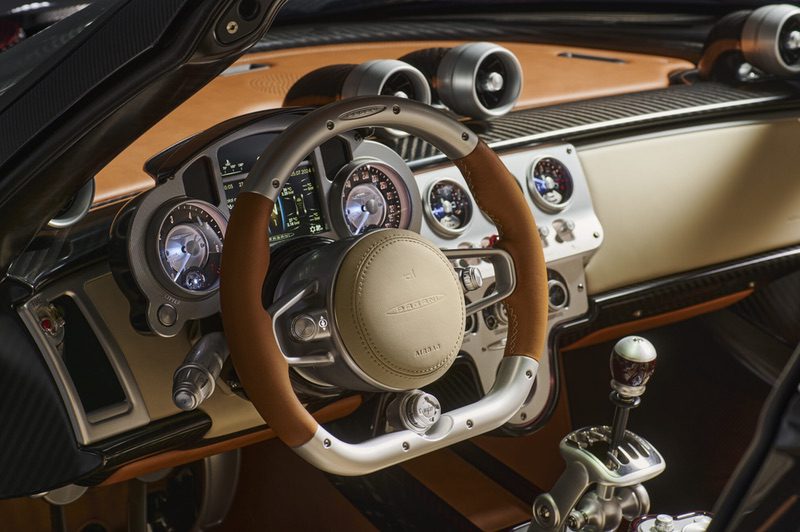
8. Exclusivity and Customization: One of One, Every Time
To own a Pagani is to join a rarified circle of collectors, connoisseurs, and automotive aesthetes. With only 130 examples of the Utopia Roadster set for production worldwide, exclusivity is not a selling point—it’s a founding principle. Each car is a bespoke creation, shaped not only by the brand’s artisans but by the vision of its owner.
At Pagani, customization isn’t confined to colour swatches and wheel options. It is a co-creative process where clients work directly with the design team to sculpt their dream car. From the hue of exposed carbon to the stitching of leather seams, from custom paint to one-off accessories—every detail can be reimagined.
Clients are invited to select from a near-infinite palette of materials: leathers of all grains and finishes, metals in brushed or polished form, anodised elements in rare hues, and carbon fibres that shimmer beneath translucent colours. Even the luggage—crafted from leather-wrapped carbon shells—is tailored to match or contrast with the interior, blending fashion with function.
The result is that no two Utopia Roadsters are alike. One may echo the romantic minimalism of 1960s Italian design, another might channel bold futurism with satin titanium accents and deep cobalt carbon. Some owners opt for tributes to national colours, while others pursue vintage race liveries or avant-garde concepts.
What unites all is Pagani’s obsessive attention to detail. The Sport Pack, for instance, includes elements like carbon-titanium floor mats, exposed flanges on the titanium exhaust, and bespoke Aeroblade wheels, all assembled by hand in the Modenese atelier. Every thread, bolt, and surface is proof that this isn’t mass manufacturing—it’s modern coachbuilding.
Owning a Utopia Roadster isn’t about status. It’s about expression. It’s a canvas for identity, passion, and mechanical poetry. In an age of algorithmic sameness, Pagani offers something revolutionary: the power to be utterly, unapologetically individual.
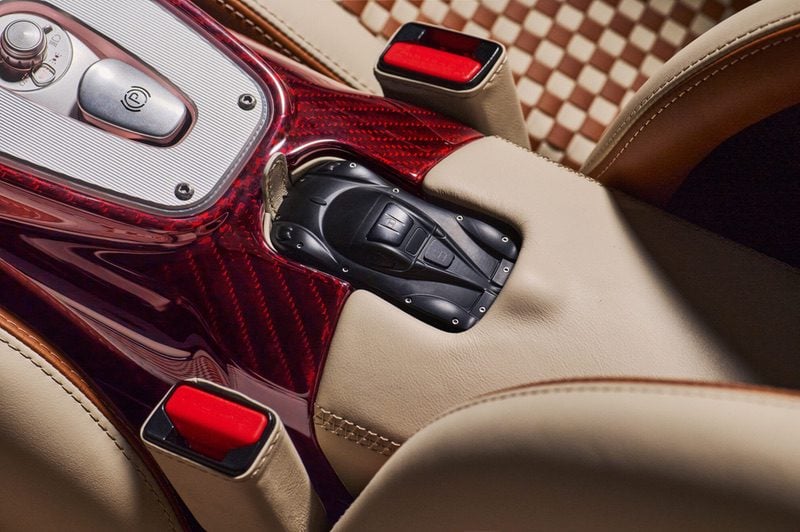
9. Collectibility and Market Value
In a marketplace saturated with digitally augmented hypercars and algorithmically controlled performance figures, the Pagani Utopia Roadster is an outlier. Not just in how it drives, but in what it represents — a rare, visceral object crafted in an era that increasingly values virtual over visceral. That makes it not only desirable, but highly collectible.
Limited to just 130 units globally, the Utopia Roadster is built for a niche audience: those who appreciate rarity, heritage, and the tactility of true mechanical engagement. With a base price of €3.1 million (before taxes), it enters at the top end of the hypercar market, yet for those fortunate enough to secure a build slot, it’s an investment with a proven legacy of appreciation.
History is on Pagani’s side. The Zonda Cinque Roadster, for example, originally sold for around €1.3 million and now commands upwards of €6–10 million on the collector market. The Huayra BC Roadster has followed a similar trajectory, with resale values far exceeding their original list prices. This is a brand with a reputation for exclusivity — not through hype or scarcity gimmicks, but through unwavering craftsmanship and uncompromised artistry.
The Utopia Roadster, with its manual gearbox, non-hybrid V12, and deep commitment to analog purity, offers something truly unique in the current hypercar climate. It’s not just a car; it’s a defiant celebration of what hypercars used to be — and what they still can be, when emotion is allowed to lead.
Moreover, its design is timeless rather than trend-driven. Where some modern hypercars may look dated in a decade, the Utopia Roadster channels classical forms and artisanal finishes that ensure enduring visual appeal. As Pagani often says, art should transcend the fashion of its time — and this car is rolling sculpture.
Whether viewed as a garage centrepiece, a concours-ready masterpiece, or an exhilarating backroad companion, the Utopia Roadster carries with it the hallmarks of a future classic. For collectors, it’s not just about ROI — it’s about owning a chapter of automotive history, written by one of the last true romantic engineers.
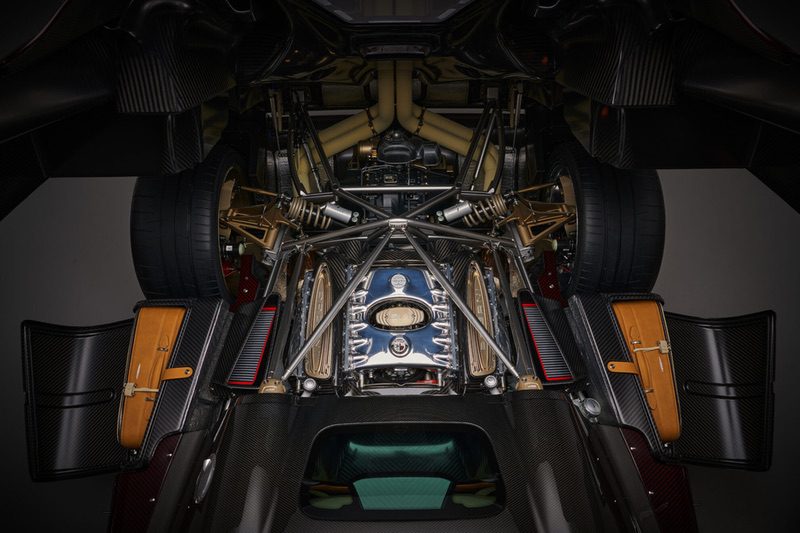
10. Comparison: Pagani Utopia Roadster vs Competitors
In a landscape dominated by futuristic hybrid systems and aggressive spec-sheet wars, the Pagani Utopia Roadster dares to go a different way. Rather than chasing Nürburgring lap times or cramming in semi-autonomous tech, it focuses on beauty, craftsmanship, and driver engagement. But how does it stack up against other flagship hypercars of its era?
Let’s begin with the Bugatti Tourbillon, a hybrid successor to the Chiron boasting a naturally aspirated V16 engine paired with electric motors. With a power output north of 1,800 hp and cutting-edge aerodynamics, the Bugatti is a feat of modern engineering. However, it leans heavily into the digital future. The Utopia Roadster, by contrast, embraces analog purity — delivering thrills not through brute numbers, but through tactile feedback and driver involvement.
Then there’s the Koenigsegg CC850, another manual-hypercar icon. With its innovative Engage Shift System (ESS), it bridges manual emotion with automatic adaptability. The Utopia Roadster, however, offers a more traditional take: exposed mechanical linkages, a classic gated shifter, and a focus on simplicity. Where the CC850 is tech-forward and clever, the Pagani is soulful and sculptural.
Looking to the Aston Martin Valkyrie Spider, we see another distinct approach — an F1-derived V12 hybrid with uncompromising downforce and a stripped-back, track-first aesthetic. It’s raw and intense, but far more specialized. The Utopia Roadster offers broader usability, daily-drive comfort, and a timeless interior that feels more habitable than hardcore.
In many ways, the Utopia Roadster doesn’t aim to compete head-to-head — it seeks to transcend. While rivals chase records and innovation for its own sake, Pagani creates cars that are personal, artistic, and emotionally resonant. It may not win on paper, but in the hearts of drivers and collectors, it stands alone.
This isn’t about choosing the fastest. It’s about choosing the most memorable. The Utopia Roadster wins not because it outguns — but because it outcharms.

11. Frequently Asked Questions (FAQ)
Q: How many Pagani Utopia Roadsters will be produced?
A: Only 130 units of the Pagani Utopia Roadster will be built, making it one of the rarest hypercars in the world.
Q: What is the price of the Utopia Roadster?
A: The starting price is €3.1 million, excluding taxes and options. Customisations and exclusive finishes can significantly raise the final cost.
Q: Is the Utopia Roadster road legal globally?
A: Yes. Pagani designed the Utopia Roadster to meet the world’s strictest safety and emissions standards, passing over 50 crash and homologation tests.
Q: What kind of engine does the Utopia Roadster have?
A: It features a twin-turbocharged 6.0-litre V12 engine developed by Mercedes-AMG, producing 864 hp and 1,100 Nm of torque — without any hybrid assistance.
Q: Does the Utopia Roadster have a manual gearbox?
A: Yes. In fact, it offers a seven-speed manual transmission with an open-gate titanium linkage. An AMT (Automated Manual Transmission) version is also available for those who prefer paddle shifting.
Q: Can I drive the Utopia Roadster daily?
A: While it’s a high-performance hypercar, the Utopia Roadster was designed with comfort in mind. With its supple suspension, refined cabin, and driver-friendly ergonomics, it can be driven on public roads — and enjoyed — daily.
Q: What is the top speed and 0–100 km/h time?
A: Exact figures haven’t been officially released, but with 864 hp and a weight of 1,280 kg, the Utopia Roadster is expected to hit 0–100 km/h in under 3 seconds and exceed 350 km/h (217 mph).
Q: What tyres come with the Utopia Roadster?
A: Pagani fits the car with Pirelli P Zero™ tyres as standard, with optional P Zero™ Trofeo RS tyres for track performance. The tyres also feature Pirelli Cyber™ Tyre sensors for live feedback.
Q: Will the Utopia Roadster appreciate in value?
A: Based on the track record of past Pagani models like the Zonda and Huayra, appreciation is likely — especially given its analog drivetrain and ultra-low production volume.
Q: Can I customise every detail of the car?
A: Yes. Pagani offers near-limitless personalisation. From exterior paint and carbon fibre finishes to leather colour, stitching, and accessories, each car is a bespoke masterpiece reflecting its owner’s taste.

12. Conclusion
The Pagani Utopia Roadster is more than just a hypercar — it is a declaration. In an era racing toward digitalisation, automation, and electrification, Pagani takes a defiant stance by embracing the analog, the mechanical, and the emotional. It is a machine created not by focus groups or algorithms, but by artisans, engineers, and dreamers.
From its roaring V12 and exposed manual gearbox to its bespoke, sculptural interior and lightweight carbon-titanium chassis, every element of the Utopia Roadster is designed to stir the soul. It’s a car for those who seek more than speed — for those who want engagement, beauty, and narrative with every journey.
With only 130 units available worldwide, its collectibility is guaranteed. But for those lucky enough to own one, the real value lies in the experience. It is a car to be driven, admired, and passed on like a treasured heirloom.
The Utopia Roadster doesn’t just reject compromise — it redefines the very idea of what a hypercar can be. It is art on wheels, sound in motion, and emotion in metal. In short, it is Pagani at its most pure.
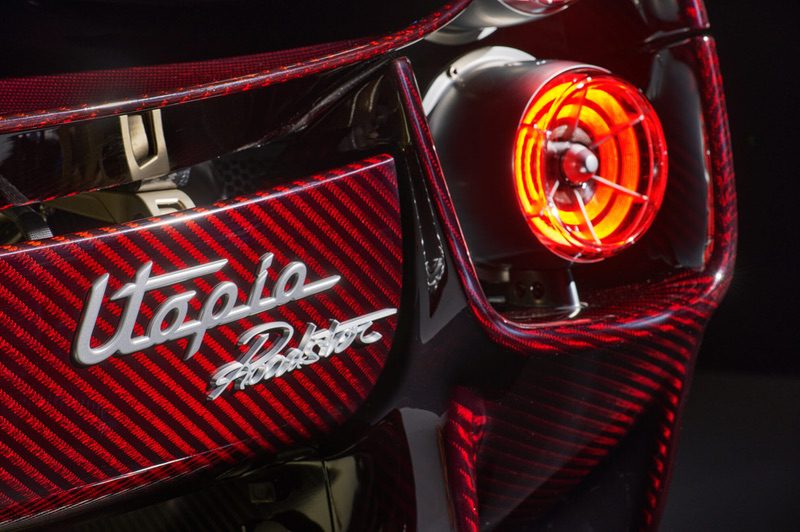
13. Technical Specifications
-
Power: 864 hp (635 kW) at 6,000 rpm at 18° C
-
Torque: 1,100 Nm from 2,800 to 5,900 rpm
-
Engine: Pagani V12 60° 5,980 cc twin-turbocharged, developed by Mercedes-AMG
-
Gearbox: Pagani by Xtrac 7-speed transversal AMT (Automated Manual Transmission) or pure manual, with electro-mechanical differential
-
Drivetrain: Rear-wheel drive
-
Chassis: Monocoque made from Pagani Carbo-Titanium HP62 G2 and Carbo-Triax HP62 with front and rear tubular subframes in chromium-molybdenum alloy steel
-
Suspension: Independent double wishbone in forged aluminium alloy with helical springs and electronically controlled dampers
-
Brakes: Pagani by Brembo, carbon-ceramic ventilated discs
-
Front: 410×38 mm with 6-piston monolithic calipers
-
Rear: 390×34 mm with 4-piston monolithic calipers
-
-
Wheels: Forged monolithic aluminium alloy
-
Front: 21”
-
Rear: 22”
-
-
Tyres:
-
Pirelli P ZERO™ Corsa: 265/35 R21 front, 325/30 R22 rear
-
Pirelli P ZERO™ Winter option for colder climates
-
-
Dry Weight: 1,280 kg (2,822 lbs)
-
Dimensions:
-
Length: 4,673 mm (184.0 in)
-
Width: 2,060 mm (81.1 in)
-
Height: 1,165 mm (45.9 in)
-
Wheelbase: 2,796 mm (110.1 in)
-
-
Top Speed: 350 km/h (217 mph), electronically limited
Photos Credit:

